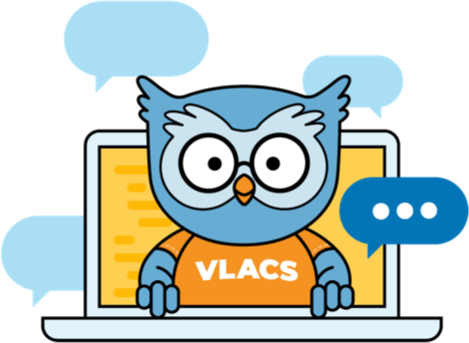
Open House for New Families
Are you ready to customize your education and start learning on your terms? Consider attending an …
Compass, our new student information system, is now available to all students. Guardian user accounts will be created over the next few days. Please contact us if you need assistance.
Customized Learning
Competency-based learning prioritizes what you learn, not how much time you spend learning. Under this model, you can learn in many different ways and progress in your course as soon as you master the academic content, regardless of place or pace of learning.

At VLACS, we define competencies as the big ideas, concepts, and enduring understandings that students are expected to master before moving on in their studies. Each VLACS course, project, or experience is designed to help you master a specific group of competencies.
Students will demonstrate an understanding of the business of marketing and advertising by analyzing the impact of a budget and finances on advertising production and market buying decisions.
There is no pre-determined timetable when enrolled in a competency-based education program. Instead, you can take the time to understand and comprehend the course material adequately. And while acceleration is allowed, if you need extra support to meet a competency, time is on your side.
Everyone learns differently, and not every student succeeds in the typical classroom setting. With competency-based learning, you have the opportunity to tailor your learning style to make course material relevant to your life.
When enrolled in a competency-based school, you are expected to work at a pace that meets your academic needs, which means that you will master competencies at different times.
In a traditional school model, you may be able to overcome a failing test grade by doing well enough on other tests to bump up your grade. Unfortunately, that means you’ve missed out on mastering an important competency, which will make further learning more difficult.
In a competency-based setting like VLACS, you continue working on concepts and skills until you demonstrate understanding.
Here, the goal is not to earn a “good enough” grade to advance. It’s about truly understanding something so knowledge is retained for the long term, not the short term.
If you are willing to do the work, the concept of failure does not exist within the VLACS competency-based model. You may fall short of demonstrating competency on an exam or project, but you will not be labeled a “failure.”
Much like the bar exam, the real estate licensure exam, or a driver’s test, each assessment serves a dual purpose of measuring competency and identifying areas that still need attention. At VLACS, failure is replaced with “not ready yet,” and your teacher is available to help get you where you need to be.

When taking our courses, competency is measured by passing specified competency assignments, including projects, papers, exams, or quizzes, with a grade of 85 or better and having greater than a 60% average in the course.
You are allowed multiple attempts on assignments and are supported by your VLACS instructor as you work to demonstrate your understanding of the course competencies.
Each course has a pre-determined set of competencies, outlined in our learning catalog.
Projects and experiences are assessed using a rubric on a three-point scale: approaches competency, meets competency, or exceeds competency. With these learning options, competency is demonstrated through various different ways, such as a presentation, prototype, portfolio, or poster.

Are you ready to customize your education and start learning on your terms? Consider attending an …

Everything you need to know before enrolling your child in virtual learning If you’re a parent …

Whether you are just beginning your elementary experience at VLACS or you are exploring educational …

Have a VLACS question? Search our Knowledge Base for instant answers about our programs, courses, admissions, and more.
Have questions about how VLACS can support you and your child? Join us for a virtual open house to get all the information you need.
